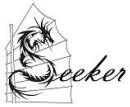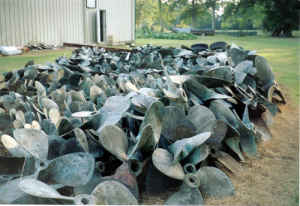Other Propeller Options
Folding or Feathering Props (Pricy)
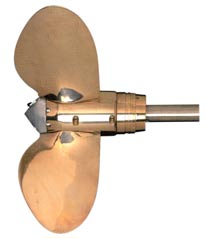
Max-Prop self feathering prop |
|
If you can control the pitch at the push of a button then the
next best thing for a sailboat is to fold or feather the props
blades so the don't slow the boat down when it's under sail power.
Max-Prop; www.max-prop.com
manufactures and sells a self feathering props in a range of blade
configurations. I'd love to have one, but our boat would require a
35", 3 blade propeller and the cost is $15,500. And
being a workboat I doubt it would be very long before I was needing
to replace a blade or two due to damage caused by operator error.
Affordable Fixed Pitch Props (Better)
Buying a Prop
If you live on the coast this will be a piece of cake, but if you
live in Tulsa, Oklahoma you will likely have to shop by email.
Brent Swain's advise "Get a prop within 4 inches of the pitch you
want, preferably closer. Any more and if you try to re-pitch a prop
more than 4 inches the blade breaks off."
To test a used prop is to rest it on the hub and then tap the end
of each blade. It should produce a clear ringing. If it
is dull and short lived then pass it up.
CraigsList turned up more than a few props down toward New
Orleans, so they are out there. Check:
www.propellerplace.com
A new 36" bronze prop is
about $3,600.
Another option is a new stainless steel prop from Kahlenberg
propeller that is intended for use on work boats. We plan to
frequently work in shallow waters and close to obstacles so a
stronger prop might be worth the extra money. The price for
a 3 blade 304 stainless steel propeller 32" in diameter with a 27"
pitch, left hand, bored for a 2.5" shaft is $3,995; F.O.B. Two
Rivers, Wi. Contact: Steve Kahlenberg, Kahlenberg Bros. Co., Ph:
920-793-4507, www.kahlenberg.com.
Kevin Morin builds boats up in Alaska and he highly recommended
stainless steel wheels; "My examples were fishing commercially,
justification for these wheels was their ability to run in gravel
bars of Bristol Bay and keep running without damage."
Building a Steel Propeller from Scratch ( Yeah Baby - Field
Repairable )
I came across a bit below in the Wylo-II group from Lex
Hodgkinson.
"Hi Passepatu has had a mild steel propeller welded to a mild steel
shaft for over 14 years now, I welded up the prop from 5mm (.1967"
3/16=0.1875) plate
scraps and welded this directly on to the shaft. This system has
been pretty much trouble free
with only two cases of mild pitting on the blades when I allowed the
small anode on the prop boss to get eaten away. This was remedied
with an electric weld build up of the pitted areas followed by
grinding, all done in Situ.
(on the hard!) The system has a small anode on the prop boss, a
small one on the rudder and a similar one on the hull close to the
prop shaft area. I cast these myself, they are roughly 1" dia by one
inch long and last around a year.
The propeller is painted with chlorinated rubber paint (as is the
whole boat) and antifouled with the same paint as the hull
(ablating, not the best but I found "hard" antifouling to last even
less) The shaft bearing is "Thordon" or similar, some sort of fibre,
and has never been replaced, the inboard seal is a "dripless" fibre
ring that bears on a bronze plate, which I replaced with stainless
steel. Works ok but the grease filled shaft leaks grease inboard,
just a nuisance. No water leakage at all, just cobwebs in our bilge!
We have no inboard bearing, all thrust being taken by the Hurth
gearbox.
We have a dry exhaust and therefore no cooling water to exit at this
seal and cool it, (I think that was the cause of the bronze plate
wearing too fast) The whole thing works very very well, cost begger
all and seems to incur no problems, I would be far more nervous with
a thousand dollars or more tied up in a machined stainless shaft
with bronze prop. I have a grease gun piped into the prop shaft tube
and give it a squirt now an then.
Incidentally it is easy to alter the pitch if you feel so inclined,
by either belting it with a hammer or twisting the blades with a
large wrench The prop is two blade 17x11 approx and the motor a 35hp
Nannidiesel. It will max out at around 2500 rpm (max design rpm 3000)
Hope this helps, DONT let the "experts" say you cant do this in mild
steel, it works and can be repaired or replaced easily and cheaply,
Incidentall we have been careful not to have anything but mild steel
underwater. Lex"
Lex is using a 1.8 to 1 Hurth gearbox, so the 3000 engine RPM is
1666 at the prop.
"The prop was built using a simple steel jig to compare the blade
shapes to ensure they were the same and at right angles to each
other, pitch was checked at two or three locations with more
attention paid to the outer 1/4 and the tips. Balance was checked
simply by mounting on centers and grinding to achieve no bias. The
blades with some reinforcement at the roots were mounted into slots
cut into a 2"dia hub which was drilled to 1 1/4" to accept the
shaft. The hub is welded to the shaft only at the aft end."
--Lex.
Our prop is 36", not 17" so we got a bit more force involved in
order to pitch the blades. They make special anvil called a
"pitch block" for hammering a prop into shape, but that's for
smaller speed boat props. However a pattern would be really
helpful when bending the blades.
Propeller Design
Rotation
Most engines are left hand rotation. Meaning that if you
look at the engine's fly wheel from the back it will rotate
counter clockwise, or the top of the flywheel will be moving toward
the left. Also most inboard props are left hand meaning they push
the boat forward when they spin counter clockwise as seen from the
back end.
Prop Sizing
A good place to start is with some of the manufacturers sites
like Michigan Wheel:
www.miwheel.com/propellers/prop-it-right/
Max allowable propeller diameter 34" - 36" Need 10%
clearance between the blade tip and bottom to reduce noise.
Vessel Max & cruising boat speeds 12 knts max 10 knts cruise in 15
knt wind
Displacement, length & LWL of the vessel 40 ton, 20 ton cargo, 74ft,
28ft
Shaft length: 20 ft ??
Using a Cummins C8.3 210 hp, 2400 max rpm, 446 lbft @ 1300
rpm
The following calculations are from Boat Mechanical Systems
Handbook
DAR=0.5 for 3 bladed standard prop, 0.7 for 4 blades.
Min Prop Diameter Inches as a function of blade area or DAR = sqrt(
( 125 * hp) / (DAR * max kts * sqrt( max kts) ) )
sqrt( ( 125 * 210) / ( 0.5 * 11 * sqrt(11) ) ) = 37.9 inches for 3
blade
sqrt( ( 125 * 210) / ( 0.7 * 11 * sqrt(11) ) ) = 32 inches for 4
blade
Ballpark shaft diameter is 1/14 of the prop diameter; or 37.9 / 14 =
2.7 in for 3 blade and 32 / 14 = 2.3 in for 4 blade.
Shaft Dia In = cube root ( (321000 * ( .96 * hp ) * SF ) / (
316 Stainless
Steel Yield * ( rpm / reduction ) ) )
SF= Safety Factor
Shaft Dia In = cube root ( (321000 * ( .96 * 210 ) * 4 ) / ( 40000 *
(2400 / 3 ) ) ) = 2 inches
Using an Allison 545
automatic transmission in 1st gear with reduction of 3.45:1
Engine 2,500
RPM = 725 Shaft RPM
Engine 1,600 RPM = 464 Shaft RPM
Using a Marine Tranmission with a 4:1 reduction ratio
Engine 2,500
RPM = 625 Shaft RPM
Engine 1,600 RPM = 400 Shaft RPM
From Dave Gerr's book "Boat Mechanical Systems Handbook"
Minimum Blade Area & Diameter for Displacement Hulls
= sqrt((125 * hp) / (Disk Area Ratio .5 for a 3 blade std prop * kts
* sqrt(kts)))
= sqrt( (125 * 200) / (.5 * 11 * sqrt(11) ) = 37.0 inches
Prop Tip to Bottom of Hull = .2 * prop diameter 37.0 =
7.5 inches
Between Prop and Rudder = .15 * prop diameter 37.0 = 5.75
inches
Between Prop and Skeg = .3 * prop diameter 37.0 = 11.25 inches
Rough Shaft Diameter = 1/15 * prop diameter 37.0 = 2.5 inches
Shaft Dia = cubrt( (321,000 * 200 hp * .96 [shaft hp] * 4 Safety
Factor) / ( 20,000 psi yield strength 304 stainless * 725 rpm))
= cube root ( (321000 * (200 * .96) * 4) / (20000 * 725) ) = 2.57
inches
An 36" bronze prop from deepblueyachtsupply.com is $3,610 (2011) and
it requires a 2.75" shaft.
A 2.75" x 10ft shaft in Aqualoy 17 from deepblueyachtsupply.com is
$1,700. (2011)
Shaft Bearing Spacing if feet = 4.6 * sqrt( Shaft Dia )
= 4.6 * sqrt( 2.5 ) = 7.27 feet
= 4.6 * sqrt( 2.75 ) = 7.62 feet
Thrust Pounds = ( 326 * shaft hp [200 * .96] * displacement hull
propeller efficiency .55 ) / ( .9 * knots 10 )
= ( 326 * 200 * .96 * .55 ) / ( .9 * 10 ) = 3,825 pounds
1,275 pounds per 16 inch blade
From Dave Gerr's "Propeller Handbook"
Torque = (5,252 * hp) / rpm
(5,252 * 200 * .96) / 2,500 = 404 pounds feet
Hull Speed = 1.34 * sqrt ( water line
length )
1.34 * sqrt ( 68 ) = 11 knts
SL Ratio - Speed / Length or theoretical
hull speed when the wave length is equal to the waterline length.
Kts =11 Desired Speed in knots
WL=68 Water Line
LB=80,000 Displacement in Pounds
SHP= 200 * .85 Shaft Horsepower =
170 Hp
SL RATIO = Kts / sqrt(WL) = 11 / sqrt(68) =1.33
From the SL RATIO chart, an SL RATIO of 1.33 gives LB/HP
(Pounds/Horsepower) of 525
80,000 / 525 = 152.3 Hp
Pitch and angle of the blade are not the
same. Consider that the root of the blade closest to the boss
cuts through much less water in one revolution than does the tip of
the blade. So the tip of the blade has a much smaller angle to
the shaft that the root. If both the tip and the root are
pitched the same then both would travel the same distance through
the water when given one rotation.
Bad Vibrations
The frequency in Hz transmitted by the propeller to the hull is
given by
where: n = number of blades N = number of rpm of the propeller
shaft.
Source:
www.nautica.it/superyacht/527/tecnica/vibrations.htm
So our 3 blade prop turning at 500 cruising to 719 RPM running at
wide open throttle gives us an frequency from 25 to 36Hz. If we
dropped to 2 blades, that would be 17 to 24Hz.
A prop also have a natural frequency which is mainly derived by the
length and thickness of the blades. If you whack the blade with a
hammer, it will resonate at it's "natural frequency", like a tuning
fork. If the generated frequency from the RPM is close to the props
natural frequency then the amplitude or strength of the vibrations
will greatly increase. Like two kids on either end of a jump rope.
If one shakes the rope up and down fast and the other does it slow
then the rope never bounces that high. But if they get in sync with
each other then the wave in the rope is magnified. Soon the rope
breaks and hits both kids in the head and their parents subsequently
sue the school for not training their kids on how to properly use a
jump rope; but I digress.
So the idea is to separate the frequencies as much as possible. The
natural frequency of the prop is a function measurement of how stiff
the blade is built. A really thick, stiff blade will have a higher
frequency that an thinner, floppier blade. Since a floppy blade is
easier to destroy it makes since to make the blade with a higher
frequency. The problem is that the bigger the blades the lower the
natural frequency. We could make the frequency created by spinning
the prop higher by increase the rpm, but that adversely impacts
power. However a 3 blade prop is better that 2 so that is an easy
choice. And since adding thickness to a blade only slightly affects
it's performance. Doubling the plate at the root of the blade would
likely go a long way increasing it's frequency. It won't do any harm
when it smacks into a log either.
Is that it? I don't guess there is an easy way to predict the
natural frequency of a blade is there?
Stuffing Box / Shaft Seal
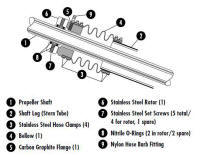
PSS Seal |
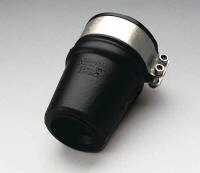
Volvo, Rubber Stuffing Box |
| |
|
|
PSS Dripless
Shaft Seals are a popular choice but they do leak when shifting
directions if the shaft has any slip in a thrust bearing, and they
are also $440 for a 2" shaft. For me the down side is that the
PSS is not designed for contact with oil or grease and I may want to
use a mild steel driveshaft and protect it by sealing the outboard
end of the shaft log and flooding the log with oil.
Volvo Penta makes a
Rubber Stuffing Box for 2" shafts with 2 3/4” sleeves which sell
for $165 (2010). They say to grease it every 200 hours so it
should be fine to flood the shaft log with oil. The requirement for
a 2 3/4" sleeve is a bit of a problem too as a 2 1/2" pipe has an OD
of 2.88". Water resistant grease is applied to the inside
of the seal by squeezing the sleeve to vent it and then applying the
grease to the inside.
A
Traditional Stuffing Box, drips, and we don't want the drip,
especially if we flood the shaft log with oil to protect the log and
steel shaft.
Prop Resources
www.boatdiesel.com
www.usedprop.com
www.a1discountprop.com
www.tacomapropeller.com
|
